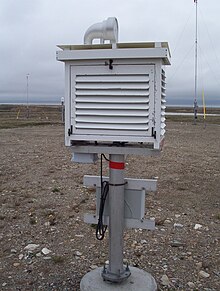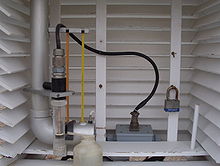Stevenson screen: Difference between revisions
Sharkface217 (talk | contribs) m Reverted edits by 203.116.55.2 to last version by ClueBot |
|||
| Line 9: | Line 9: | ||
==Composition== |
==Composition== |
||
The traditional |
The traditional Stevenso Screen is a box shape, constructed of wood, in a double-[[louver]]ed design. However, it is possible to construct a screen using other materials and shapes, such as a triangle. The [[World Meteorological Organization]] (WMO) agreed standard for the height of the thermometers is between 1.25 m (4 ft 1 in) and 12 m (6 ft 7 in) above the ground. |
||
==Size== |
==Size== |
||
Revision as of 03:59, 14 May 2008
This article needs additional citations for verification. (January 2007) |
This article needs attention from an expert in meteorology. Please add a reason or a talk parameter to this template to explain the issue with the article. |


A Stevenson screen or Instrument shelter is a meteorological screen to shield instruments against precipitation and direct heat radiation from outside sources, while still allowing air to circulate freely around them.[1] It forms part of a standard weather station. The screen creates, as near possible, a uniform environment in relation to the air outside. The Stevenson screen is usually designed to hold various instruments including thermometers (ordinary, maximum and minimum), a hygrometer, a dewcell, a psychrometer, a barometer and a thermograph. Stevenson screens may also be known as a cotton region shelter, an instrument shelter, a thermometer shelter, a thermoscreen or a thermometer screen. The use of a standard screen allows temperatures to be compared accurately with those measured in earlier years and at different places.
History
It was designed by Thomas Stevenson (1818-1887), a British civil engineer and father of the author Robert Louis Stevenson.
Composition
The traditional Stevenso Screen is a box shape, constructed of wood, in a double-louvered design. However, it is possible to construct a screen using other materials and shapes, such as a triangle. The World Meteorological Organization (WMO) agreed standard for the height of the thermometers is between 1.25 m (4 ft 1 in) and 12 m (6 ft 7 in) above the ground.
Size
The interior size of the screen will depend on the number of instruments that are to be used. A single screen may measure 765 mm high by 610 mm wide by 593 mm deep (30.1 in by 24.0 in by 23.3 in) and a double screen 765 mm high by 1050 mm wide x 593 mm deep (30.1 in by 41.3 in by 23.3 in). The unit may be mounted on a wooden stand or a metal pipe.
The top of the screen was originally composed of two asbestos boards with an air space between them. These asbestos boards have generally been replaced by a laminate due to health and safety reasons. The whole screen is painted with several coats of whitewash to reflect radiation and will usually require repainting every two years.
Siting
The siting of the screen is very important to minimise the effects of buildings and trees. Environment Canada for example recommends that the screen be placed at least twice the distance of the height of the object (e.g. 20 m from any tree that is 10 m high, or 40 ft from one 20 ft high). In the northern hemisphere, the door of the screen should always face north so as to prevent direct sunlight on the thermometers. However, in Polar regions with twenty-four hour sunlight the observer must take care to shield the thermometers from the sun and at the same time avoiding a rise in temperature being caused by the observer’s body heat.
A special type of Stevenson screen with an eye on the roof is designed to be used on ship. The unit is hung from the ceiling and remains vertical despite the movement of the vessel.
Future
In some areas the use of single unit automatic weather stations are supplanting the traditional Stevenson screen (and other stand-alone meteorological equipment).
See also
External links
- Article - Temperature measurement and the Stevenson screen
- Example of a non-traditional home built Stevenson screen
References
- ^ "Stevenson Screen". Environment Canada. Retrieved 2007-12-04.
